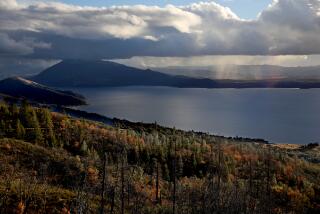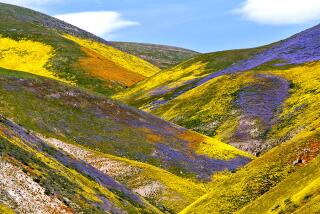Arctic Ocean mega-bloom: Scientistsâ eyes popped and jaws dropped
Nothing new in the world? Nothing left to discover? NASA would beg to differ. The discovery of an âenormous, off-the-chartsâ bloom of microscopic marine plants in the Arctic has floored scientists.
And it confirms, if nothing else, that there are things on this planet not yet seen -- things that you ânever, ever could have anticipated in a million years.â
So says Paula Bontempi of NASA. An ocean biology and biogeochemistry program manager in Washington, Bontempi spoke with the Los Angeles Times on Friday morning about the discovery.
Hereâs how it came about: Over the summers of 2010 and 2011, NASAâs Icescape expedition was exploring the Arctic waters of the Beaufort and Chukchi seas off Alaska. The expedition was spurred in part by climate-change research -- scientists wanted to know, Bontempi said, what effect changing radiation levels (from the sun) were having on Arctic.
âWe know that the ice is changing, we know that it is melting at an incredible rate,â she said. Researchers were trying to figure out what that meant for the ocean environment -- which affects all forms of Arctic life as well as the crucial fisheries industry and, thus, global economics, as Bontempi noted.
So a U.S. Coast Guard ice breaker bearing the expeditionâs researchers was chugging along in summer 2011, funneling the Arctic waters through its laboratory instruments, when, Bontempi said, someone noticed âthese huge concentrations of the plant life and said, âIs this real? Oh my God.ââ
The crew brought the ship to a halt. Remaining in place, the researchers dropped instruments over the side and began a more thorough analysis. Preliminary findings were sent to Bontempi.
âI was blown away,â she said. âI didnât think it was real.â
The bloom was vast -- a 60- or 70-mile stretch of active plant life.
The marine plants, or phytoplankton, are the base of the food chain, Bontempi said. So the finding of a bloom âon an order of magnitude unlike anything we knew existed on this planetâ could affect higher forms of life -- fish, polar bears, walruses, etc.
Itâs not just the magnitude of blooms or changes in sea ice that can have an effect, she said. The timing of blooms is also significant.
Animals in the Arctic are accustomed to migrating at a certain time of the year. With the timing of such a bloom, which is a key part of the food chain, are the animals going to adjust their migratory schedule to accommodate the change?
Thatâs one among many questions scientists will be trying to answer.
Once they get over their shock.
If you had asked NASA scientists last year if they thought such a bloom was possible, Bontempi said, âthey would have said no way.â
Now âwe need to get it in gear and figure out what this means.â
ALSO:
Earth near tipping point, scientists warn
May warmth helps shatter spring temperature records
Entire DNA of fetus revealed -- and the testing is risk-free
More to Read
Sign up for Essential California
The most important California stories and recommendations in your inbox every morning.
You may occasionally receive promotional content from the Los Angeles Times.











